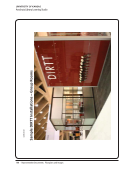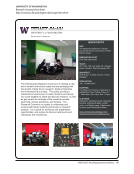16 · Survey Results: Executive Summary
Forty-three percent of the respondents reported
a wide variety of physical changes to buildings or
facilities, making this the next most significant driver
of service reconfiguration. A few fortunate librar-
ies managed to open new facilities in new or reno-
vated building spaces. Several libraries relinquished
space to other departments by closing or consolidat-
ing branch libraries. Other libraries relocated service
desks, created learning or collaboration spaces, or
provided more seating, all with an eye to better serve
their constituents.
Financial Resources or Staff
A little more than 40% of the responding libraries
reported that changes in financial resources or staff
resources were significant drivers of service recon-
figuration. But libraries that experienced stagnant or
diminished funding far outnumbered those that re-
ceived augmented funding. The majority of respond-
ing libraries have seen continued budget reductions
for the past three years. Staffing levels in several librar-
ies have been diminished by retirements without re-
placements, recapturing salary funds to cover budget
reductions. Some libraries indicated that the number
of hourly/part-time employees had also been reduced
to help cover budget cuts. Other libraries have relo-
cated/reallocated positions to provide new services
needed by constituents. Consolidation of service desks
appears to be a major method of freeing librarian time
to be able to spend more time in faculty departments
or provide more research-intensive services.
New Technology
Although new technologies seem to be surfacing daily,
about one third of the responding libraries indicated
that the availability or application of new technolo-
gies is a driving factor for service reconfiguration.
Accounts of projects throughout the survey responses
describe technology-rich services being developed
by some of the libraries. Multi-media equipment and
software are being added along with collaborative
working spaces to meet the needs of students and fac-
ulty. Examples of some imaginative application of new
technology include the use of web-based software to
schedule appointments with library faculty, the addi-
tion of software to produce library instruction, subject
specialist and collection information, integration of
library services into course management systems,
and providing multi-media hardware and software
in designated spaces within the library. Several of the
responding libraries indicated that the availability of
archival collections of serials and/or the movement to
online collections has greatly enhanced service capa-
bilities, helping to move the library “presence” outside
the physical building.
Collaboration and Outsourcing
The opportunity to collaborate with a partner outside
the library was a significant driving factor for about
one quarter of the responding libraries. Most com-
monly that partner was the information technology
unit of the parent institution. In other cases libraries
partnered with discipline-specific departments, stu-
dent services, and/or the provost’s office to develop
ideas and generate funding for projects to reconfigure
library services.
Fewer than 10% of the responding libraries indi-
cated that the opportunity to outsource a particular
service was a significant driver in the service reconfig-
uration process. One library transferred responsibility
for student printing to the university’s information
technology unit. Another library was able to merge
the billing part of the access services unit into the uni-
versity’s billing system, allowing users to pay library
fines and replacement charges through that system.
Two libraries reported that they also participate in
collaborative 24/7 chat reference services that provide
users with around the clock reference assistance.
Other Factors
Slightly more than a third of the responding libraries
chose to describe other factors that were significant
drivers in the decision to reconfigure their library
services. The common theme to nearly all of these
is the more effective and/or efficient use of library
spaces. Whether it is the need for more collaboration
space, more space for computers in a learning or re-
search commons, returning branch library space to
specific departments, or merging public services into
one service desk, nearly every library that responded
to this question is dealing with space issues at one
level or another.
Forty-three percent of the respondents reported
a wide variety of physical changes to buildings or
facilities, making this the next most significant driver
of service reconfiguration. A few fortunate librar-
ies managed to open new facilities in new or reno-
vated building spaces. Several libraries relinquished
space to other departments by closing or consolidat-
ing branch libraries. Other libraries relocated service
desks, created learning or collaboration spaces, or
provided more seating, all with an eye to better serve
their constituents.
Financial Resources or Staff
A little more than 40% of the responding libraries
reported that changes in financial resources or staff
resources were significant drivers of service recon-
figuration. But libraries that experienced stagnant or
diminished funding far outnumbered those that re-
ceived augmented funding. The majority of respond-
ing libraries have seen continued budget reductions
for the past three years. Staffing levels in several librar-
ies have been diminished by retirements without re-
placements, recapturing salary funds to cover budget
reductions. Some libraries indicated that the number
of hourly/part-time employees had also been reduced
to help cover budget cuts. Other libraries have relo-
cated/reallocated positions to provide new services
needed by constituents. Consolidation of service desks
appears to be a major method of freeing librarian time
to be able to spend more time in faculty departments
or provide more research-intensive services.
New Technology
Although new technologies seem to be surfacing daily,
about one third of the responding libraries indicated
that the availability or application of new technolo-
gies is a driving factor for service reconfiguration.
Accounts of projects throughout the survey responses
describe technology-rich services being developed
by some of the libraries. Multi-media equipment and
software are being added along with collaborative
working spaces to meet the needs of students and fac-
ulty. Examples of some imaginative application of new
technology include the use of web-based software to
schedule appointments with library faculty, the addi-
tion of software to produce library instruction, subject
specialist and collection information, integration of
library services into course management systems,
and providing multi-media hardware and software
in designated spaces within the library. Several of the
responding libraries indicated that the availability of
archival collections of serials and/or the movement to
online collections has greatly enhanced service capa-
bilities, helping to move the library “presence” outside
the physical building.
Collaboration and Outsourcing
The opportunity to collaborate with a partner outside
the library was a significant driving factor for about
one quarter of the responding libraries. Most com-
monly that partner was the information technology
unit of the parent institution. In other cases libraries
partnered with discipline-specific departments, stu-
dent services, and/or the provost’s office to develop
ideas and generate funding for projects to reconfigure
library services.
Fewer than 10% of the responding libraries indi-
cated that the opportunity to outsource a particular
service was a significant driver in the service reconfig-
uration process. One library transferred responsibility
for student printing to the university’s information
technology unit. Another library was able to merge
the billing part of the access services unit into the uni-
versity’s billing system, allowing users to pay library
fines and replacement charges through that system.
Two libraries reported that they also participate in
collaborative 24/7 chat reference services that provide
users with around the clock reference assistance.
Other Factors
Slightly more than a third of the responding libraries
chose to describe other factors that were significant
drivers in the decision to reconfigure their library
services. The common theme to nearly all of these
is the more effective and/or efficient use of library
spaces. Whether it is the need for more collaboration
space, more space for computers in a learning or re-
search commons, returning branch library space to
specific departments, or merging public services into
one service desk, nearly every library that responded
to this question is dealing with space issues at one
level or another.






















































































































































































































